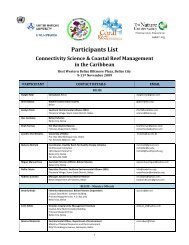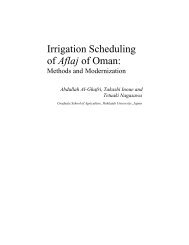The Global Water Crisis: Addressing an Urgent Security - Unu-inweh ...
The Global Water Crisis: Addressing an Urgent Security - Unu-inweh ...
The Global Water Crisis: Addressing an Urgent Security - Unu-inweh ...
You also want an ePaper? Increase the reach of your titles
YUMPU automatically turns print PDFs into web optimized ePapers that Google loves.
Office c<strong>an</strong> still be driving forces behind water allocation. This has been materialized for inst<strong>an</strong>ce, through a Presidential<br />
Decree 5 denying the core principles of the Law.<br />
Thus, there are early indications that the state may not be as dedicated to ch<strong>an</strong>ging govern<strong>an</strong>ce in the water sector as<br />
it is inclined to resume its own hydraulic agenda of building dams <strong>an</strong>d improving c<strong>an</strong>al infrastructures. Likewise, early<br />
signs indicate that local institutions do not adapt swiftly <strong>an</strong>d smoothly in accord<strong>an</strong>ce with the spirit of the Law (Thomas<br />
et al., forthcoming).<br />
However, what the field results also indicate is that despite defying the govern<strong>an</strong>ce principles of the <strong>Water</strong> Law, the<br />
institutional arr<strong>an</strong>gements at work in 2011 led to relatively positive, although limited, outcomes in terms of water access<br />
for downstream water users. An <strong>an</strong>alysis of the factors that triggered these positive outcomes even suggests that a strict<br />
application of the promoted policy models (i.e. decentralization <strong>an</strong>d devolution of decision-making power to water users)<br />
may be counter-productive for water access in downstream areas, at least in the short term. In other words, what may be<br />
gained in terms of ‘good water govern<strong>an</strong>ce’ may come at a cost in terms of water access results (Thomas et al., forthcoming).<br />
An overarching criticism is that most of the efforts have been focused on the development of national strategies, laws,<br />
policies <strong>an</strong>d regulations in a country where the impact of national law is limited at the local level when it comes to water<br />
m<strong>an</strong>agement. Thus, in their endeavour, the government <strong>an</strong>d its foreign advisors have largely failed to appear as a relev<strong>an</strong>t<br />
<strong>an</strong>d legitimate actor to resolve practical water m<strong>an</strong>agement issues. Consequently, not only do traditional institutions<br />
continue to function or evolve independently along their own path, often outside the realm of the reform framework,<br />
but their buy-in vis-à-vis new govern<strong>an</strong>ce mech<strong>an</strong>isms is also still very limited.<br />
One recommendation would be to start working more closely with existing institutions on the resolution of practical<br />
problems related to water allocation rather th<strong>an</strong> superimposing new org<strong>an</strong>izations <strong>an</strong>d regulations. And although it<br />
may be too early to begin critiquing the effectiveness of the efforts invested for improving govern<strong>an</strong>ce in river basin<br />
m<strong>an</strong>agement, it may however be wise to start questioning whether the govern<strong>an</strong>ce principles forming the pillars of the<br />
<strong>Water</strong> Law are genuinely endorsed by local actors.<br />
While the <strong>Water</strong> Law may in theory promote integration, what c<strong>an</strong> be observed in reality is rather a turf-battle between<br />
ministries. As a case in point, the Ministry of Energy <strong>an</strong>d <strong>Water</strong> (MEW) <strong>an</strong>d the Ministry of Agriculture <strong>an</strong>d Irrigation <strong>an</strong>d<br />
Livelihoods (MAIL) could not agree under which ministry <strong>Water</strong> User Associations would fall. As a result, each Ministry<br />
has its own association (Irrigation Association under MAIL, <strong>an</strong>d <strong>Water</strong> User Association under MEW) following different<br />
regulations <strong>an</strong>d creating confusion both on paper <strong>an</strong>d in practice. This separation does not respond to practical considerations<br />
for farmers on the ground. In fact, it may find its motivation elsewhere. As a senior <strong>an</strong>d key inform<strong>an</strong>t from the MEW<br />
points out: “<strong>The</strong> only interest of MEW <strong>an</strong>d MAIL in having water user associations under their responsibility is because<br />
they c<strong>an</strong> have associated infrastructure projects. Most people in these ministries have construction comp<strong>an</strong>ies involved<br />
in the rehabilitation <strong>an</strong>d construction work of different projects” (as quoted in Thomas et al., forthcoming).<br />
3.4. Infrastructure first, govern<strong>an</strong>ce later? Diverging from the imported model<br />
In the 1960s-1970s prior to the Soviet invasion, Afgh<strong>an</strong>ist<strong>an</strong> was engaged in a hydraulic mission with priority given to<br />
developing water resources through large-scale infrastructure projects, including dams <strong>an</strong>d irrigation schemes. This era<br />
was put to a stop in the early 1980s. In the early 2000s, under the influence of international donors, a strong shift towards<br />
‘good water govern<strong>an</strong>ce’ principles was initiated (Thomas et al., forthcoming).<br />
Yet, if on paper IWRM, RBM <strong>an</strong>d participation in m<strong>an</strong>agement is put forward, the MEW has yet to let go of its ambitions<br />
of dam construction, irrigation exp<strong>an</strong>sion <strong>an</strong>d hydropower generation. For inst<strong>an</strong>ce, in 2008, the <strong>Water</strong> Sector Strategy<br />
(2008) listed no less th<strong>an</strong> 45 programmes <strong>an</strong>d projects for the <strong>Water</strong> Sector for a total cost of almost US $3.8 million.<br />
Close to 80% of the costs are attributed to dams (mainly medium- to large-sized) <strong>an</strong>d c<strong>an</strong>al infrastructure rehabilitation.<br />
Multilateral donors have so far been reluct<strong>an</strong>t to support these large-scale infrastructure ambitions (in part due to<br />
5 This document has not been published. It is <strong>an</strong> order (n°1406) signed by President Hamid Karzai <strong>an</strong>d endorsed by the Ministry of Energy <strong>an</strong>d <strong>Water</strong><br />
(MEW), the Ministry of Agriculture, Irrigation <strong>an</strong>d Livestock (MAIL), the Independent Directorate for Local Govern<strong>an</strong>ce (IDLG), the Supreme Court<br />
<strong>an</strong>d the Ministry of Interior (MoI). For a detailed description of the content <strong>an</strong>d for <strong>an</strong> <strong>an</strong>alysis of the process of making this decree, see Thomas et<br />
al., (forthcoming).<br />
<strong>Water</strong> Govern<strong>an</strong>ce Reform in Afgh<strong>an</strong>ist<strong>an</strong>: Early Lessons for a <strong>Water</strong>-secure Future<br />
Part 2<br />
117




